How do you make airport toilets great?
One of the first things I was told when I started working with airports, was that ultimately passenger satisfaction is all about the toilets.
While it’s true that there is a general correlation between overall satisfaction and the toilet experience, what is very clear is that poor experiences in the toilets are often very strongly linked to passenger overall dissatisfaction. Therefore while it is good to have a great washroom experience, it is essential that the passenger does not have a bad experience.
Creating a great toilet experience is something that is a headache for airports all over the world. At the heart of the problem is quite simply the basics – having enough washrooms in the right places and keeping the washrooms clean. If they are not clean then passenger reactions range from disappointment to disgust. If it’s disgust it often colours the passenger’s whole impression of the airport.
What interests me however, is how airports can turn the washroom experience from a negative or neutral-at-best to a positive impression.
Basic steps
The first step is often to remove the door and make passengers walk around the corner to create privacy. I can’t emphasize how much people appreciate not having a door in an environment as busy as an airport.
Some airports such as Jacksonville (above) have then tried to brighten up the entrance suggesting you will be in the clouds; others such as Mumbai have looked to make the most of their history and culture by creating stylized men/women drawings to signpost the washroom.
Personally I really appreciate the airports’ efforts in both cases for taking the mundane and trying to make it more pleasant.
Other airports such as George in South Africa have taken this a step further by putting flowers in the toilet – a nice touch – it won’t make the passenger feel better if the toilet is dirty, but can transform older facilities by giving them a more personal feeling. This is particularly true in smaller airports like George.
As if you were in a hotel
As so often in the airport industry, Singapore has taken this idea to a different level.
The toilets in terminal 3 frequently bear more resemblance to those of a 5 star hotel than an airport. This really does give the impression that when you travel through Singapore, you are travelling first class.
Other airports such as San Francisco have clearly spent a considerable amount of time with interior designers, making the washroom as light as possible, but not being afraid to use dark materials to try and conceal water around the sink areas. By putting the hand driers next to the sinks, drips are reduced and I’m a big fan of the “Airblade” driers. I don’t find them as noisy as some say.
What isn’t so obvious in these pictures is just how light the washrooms are, but thanks to indirect lighting, never harsh.
San Francisco has also put some thought into how to make the ladies washroom more comfortable by adding seating. (Don’t ask what I was doing in the ladies washroom…)
Making the best of difficult situation
Another very thoughtful airport is Chongqing in China. There they have both seated and squat toilets. While this is common in many parts of the world, most people tend to prefer one or the other and don’t like to change. The consequence of mixing the two is that splashed water and footprints all over the washroom is equally common.
The key issue is that users of seated toilets often find this mess unpleasant and believe it to be unsanitary. No airport to my knowledge has solved the problem of having to wet wash the floors. But Chongqing has simply labelled the cubicles to prevent sitters from seeing the squat area and hopefully to prevent squatters from using the sitter’s cubicles. A small thing, but the small items can add up to make a difference.
Truly great
Like Singapore and San Francisco, Hong Kong has tried to provide a 5 star experience in its washrooms. The whole experience is bright and a tasteful picture of the city and the bay are there to break up the block colour of the wall, and perhaps provide encouragement.
What Hong Kong has managed to do is to get away from the “institution” feeling and create a warm, but clean ambience.
Truly innovative
For me, though, the airport which appears to have given the most thought to its washrooms is Seoul Incheon.
While ICN’s attention to detail is legendary, I’d never seen cubicles designed expressly for children. Personally I think I’d feel a bit odd using it together with one of my children, but I loved the attention to detail and thoughtfulness of it.
ICN is currently upgrading its toilets around the airport and is apparently experimenting with different designs and styles at the end of the concourses.
For me this washroom really demonstrated how a creative imagination and a little planning can completely change a mundane aspect of the airport experience. It is also practical, with basins at different heights to cater for children as well as adults. To create a modern, but relaxed ambience there are tablets attached to the walls operating on slideshow showing different Korean landscapes to provide a relaxing ambience. Tablets seem an unlikely extravagance in a toilet so I did check to see if they could be taken out, but they are firmly locked in place and can’t be removed.
I mentioned this fact to a friend who lives in Johannesburg who responded that if were South African, I would have succeeded.
Pay for the best materials you can
It is also essential that the facilities are well maintained and the best quality materials are used wherever possible. The reason is that as the materials age, they may crack, discolour or both. Unfortunately these facilities are then assumed by passengers to be dirty regardless of how clean they really are.
Poorly fitted or damaged fittings around the washroom also give a very poor impression. Refitting the washrooms on the cheap inevitably rebounds on an airport with poor satisfaction ratings and shorter lifespan.
Don’t be dark and gloomy
What the preceding photographs clearly show us is how much importance top airports place on creating a bright ambience in the washrooms.
However, many older facilities often used dark materials for the walls and flooring. While some darker material may be used, when the whole washroom is dark or even black as is the case in some washrooms in Beijing Terminal 2, the effect is actually slightly depressing and foreboding.
The argument for darker colours is often that it hides water and dirt. Unfortunately many passengers recognise this and instinctively assume that the washroom is dirty (even when it’s not). This is simply because the passenger can’t see that the washroom is clean.
Dark colours can look extremely elegant and modern, however as the facility ages they often tend toward dreary. The washrooms in Port Elizabeth often use a fairly dark grey and while I found them scrupulously clean and often brightly lit with natural light, the overall feeling was very sombre and downbeat.
Of course the reverse side of the coin is that where a lighter décor is used it is essential that the washroom is kept scrupulously clean. Indeed many of the Asian airports now station cleaners permanently in their key washrooms.
Beware unintended consequences
This drive for cleanliness has its drawbacks however.
Cleaning staff are often given little or no space to store their cleaning tools and products leading to this situation. The end urinal is not usable because staff have left mops there.
This not only annoys passengers, it also looks extremely untidy. While it is relatively common for staff to leave mops and buckets lying around the washrooms, I do feel it is unacceptable to leave cleaning products beside / under sinks. This is not only unsightly but is also a potential health hazard.
On a separate note, increasingly cleaning staff are being monitored and judged on the cleanliness of the washrooms. This can be counterproductive if staff regularly block all entrances to the washrooms in the interest of making sure that they are clean!
Equally I’m unsure about Geneva airport’s initiative to get direct feedback from passengers on the cleanliness of the toilets. The one thing I know for sure is what the previous passenger was doing before pressing the button…But apparently Geneva gets a huge amount of useful feedback.
But I’ll let Chongqing have the last word.

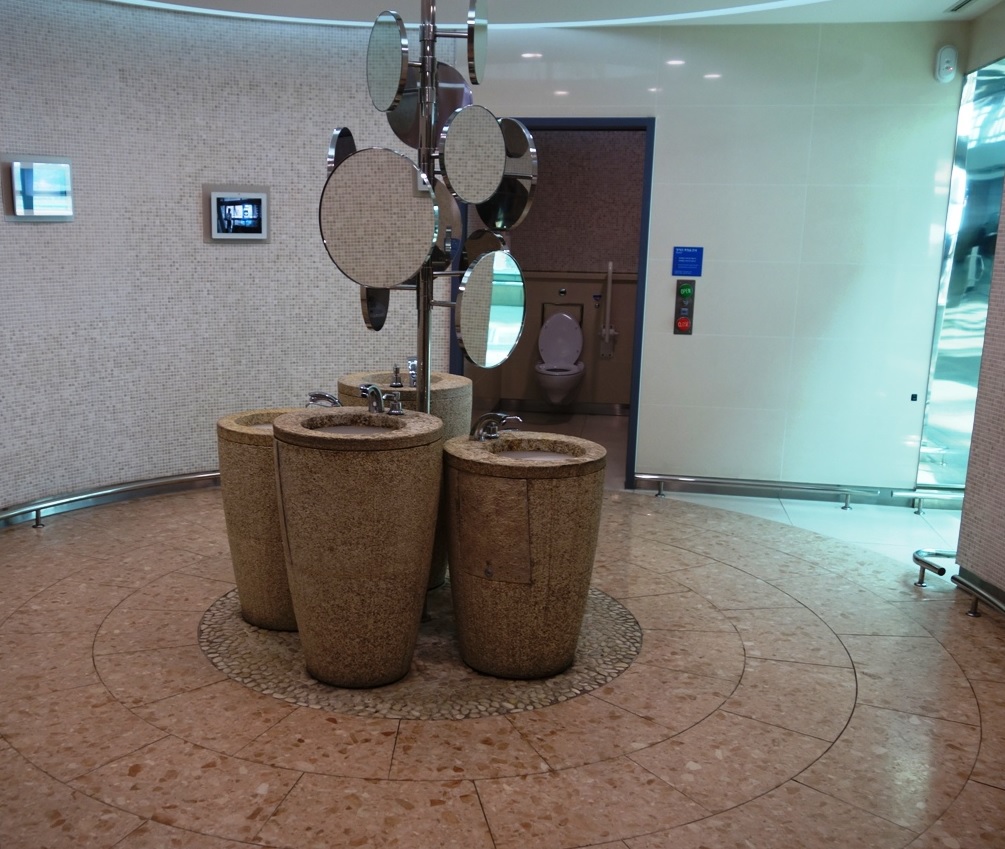


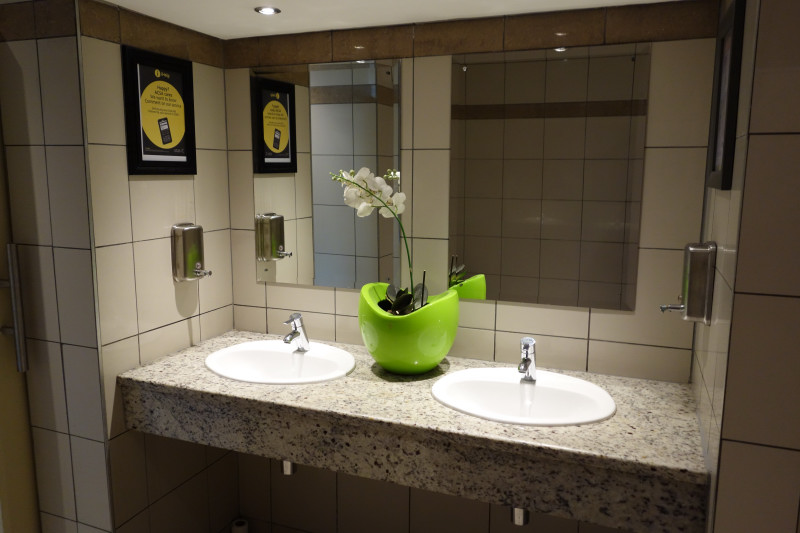





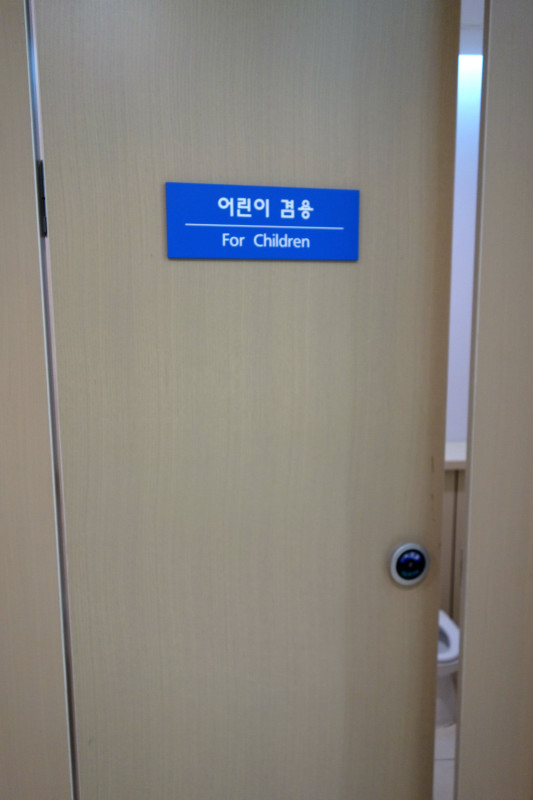
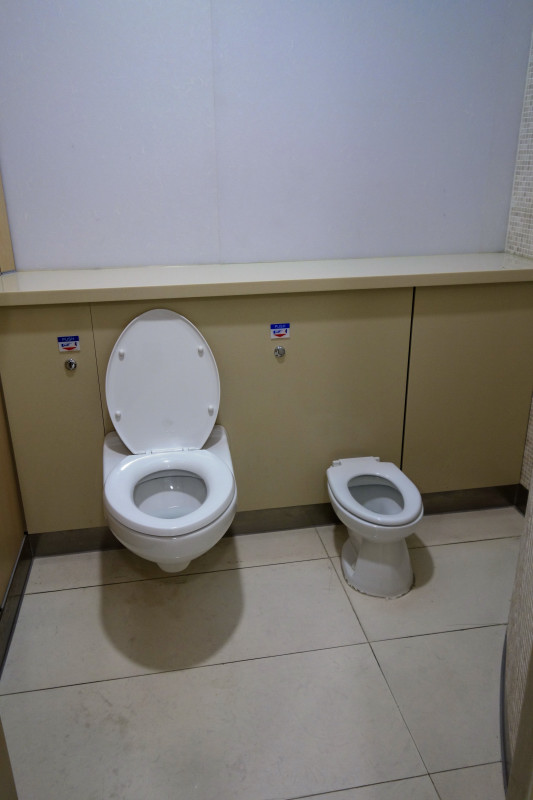





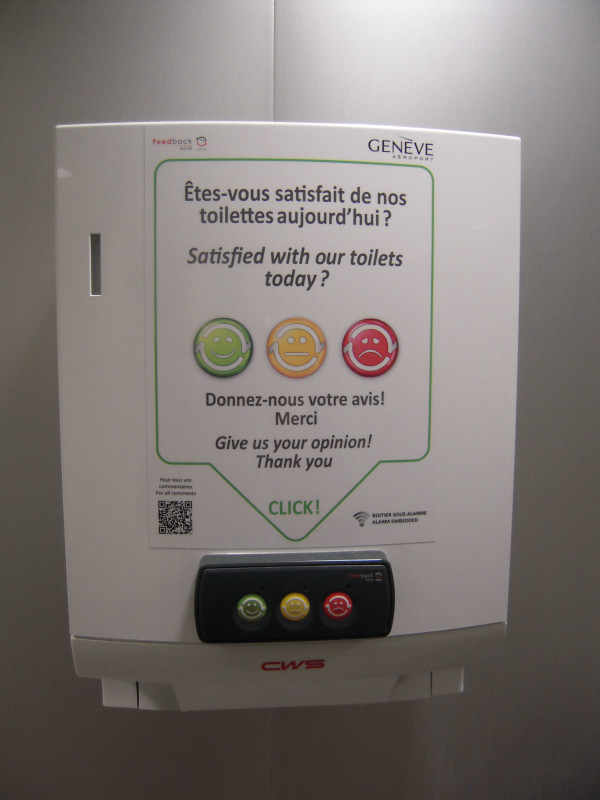

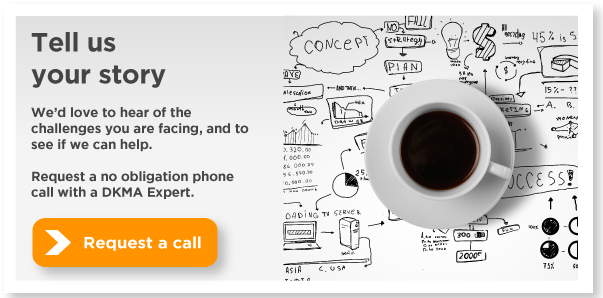

What are your thoughts on permanently mounted wall signs in the restroom entrance, i.e. Floor may be wet and slippery?
On balance I’m not in favour of permanent signs for this type of thing. I think signage should be kept to the minimum as people tend to become inured to signs and ignore them. Too much signage creates information overload and people don’t notice it. Too much signage also usually ruins any kind aesthetics designed into the facility. Obviously if there are legal reasons, then you may be obliged to put the sign in. However, even if you put the sign up, you will probably be obliged to keep putting the safety stand / cone in the middle of the floor anyway so why bother with the sign?
Thank you
The space in the female toilet cubicle in changi airport is worth a mention.
It is so roomy that you can have your trolley in there with you, which is important when you travel alone.
Also in the cubicle is a good number of door hooks and shelf space for coats and scarfs and whatever accessories hanging and dangling that one wants to rid off temporarily.
This level of attention to detail for the comfort of users is not found in most airports.